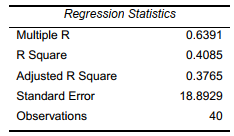SCENARIO 14-17
Given below are results from the regression analysis where the dependent variable is the number of weeks a worker is unemployed due to a layoff (Unemploy)and the independent variables are the age of the worker (Age)and a dummy variable for management position (Manager: 1 = yes,0 = no).
The results of the regression analysis are given below:

-Referring to Scenario 14-17,predict the number of weeks being unemployed due to a layoff for a worker who is a thirty-year old and is a manager.
Definitions:
Moving Average Forecast
A method used in forecasting that calculates the average of a series of data points over specific time intervals to identify trends.
Observable Trend
A noticeable movement or direction in data over a period of time that can be analyzed and used for forecasting.
Seasonality
The tendency of certain businesses or economic activities to fluctuate during specific times of the year due to changes in weather, holidays, or other recurring events.
Holt's Model
A forecasting technique that extends exponential smoothing to capture both trend and seasonality in historical data for future prediction.
Q12: Referring to Scenario 14-18, there is not
Q58: Referring to Scenario 14-4, which of the
Q78: Referring to Scenario 14-7, the department head
Q95: Referring to Scenario 13-10, which is the
Q110: Referring to Scenario 13-13, the error sum
Q139: The probability that a particular brand of
Q249: Referring to Scenario 14-4, which of the
Q252: Referring to Scenario 14-17, there is sufficient
Q281: Referring to Scenario 14-6, _% of the
Q328: Referring to Scenario 14-12, if one is